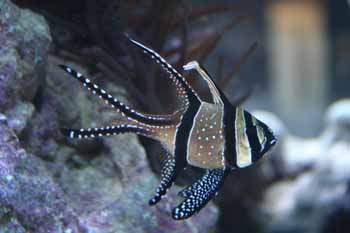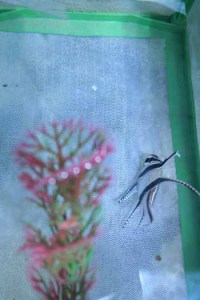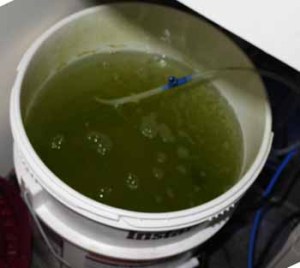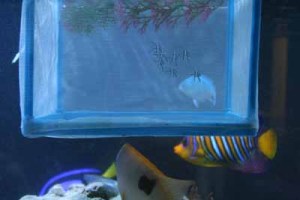
Breeding Bangi Cardinals
Why has it been so long since posts in our blog? Taking care of babies! We were lucky enough to have a breeding pair of Bangi Cardinals and the amount of time it takes to care for the parents and young is quite great. First, our older son noticed a tiny little baby Bangi Cardinal at the bottom of the tank. He was amazingly tiny, only about 1/8 inch long. We looked at the parents and noticed that the male had a mouth full of eggs and babies. After 1 1/2 hours and taking out 150 pound of live rock, we were finally able to catch the elusive male. At once, we put him in a breeder held on top of the tank with a MagFloat.

Daddy Bangi in breeder
Immediately he spit out most of what he had in his mouth, both eggs and babies. Quickly we transferred the new babies and eggs to a second breeder right next to the one with the male. After a short while the male spit out a two more babies and he was done brooding. We again, quickly transferred the babies out of the breeder with the male and put them in with the other babies.

Bangis 2 days old
After one day we had seven new little baby Bangi Cardinals. They look like adults, only way smaller. Now they are a shade smaller than 1/4 of an inch. However, what did we feed them? Our local fish store does not carry food for babies, but fortunately we had ordered Rotifers from Reef Nutrition as we thought we were going to get Ocellaris Clown Fish babies. Those eggs did not hatch, (another story), but now we had food for the baby Bangi Cardianals.
Feeding Rotifers in a mesh breeder to tiny

Rotifers
new fish is something that must be done on faith. Yes, we could see dots in the water that must be Rotifers, and yes we could see the babies moving like they were eating, but could we see the fish actually eating? Now way! Everything was too small and we were looking through a net! Here is the container where we keep and breed the Rotifers. We got our live order via overnight delivery and put it in an old salt bucket with an air stone and air pump. We add enough Rotifer Diet to keep the water green. The green is algae which the small Rotifers eat. So when the baby fish eat the Rotifers, they get vegtables (algae) and protien (the Rotifers) in a very nutritious combination. Once you have established your Rotifer colony, it will keep going as long as you feed it or don’t have a crash. You should harvest 1/3 of the Rotifers each day after 3 days. The colony can crash from under feeding, over population, and extreme temperatures.
We also began feeding our fish brine shrimp. The size of the ones at the local

Brine Shrimp
fish store were way too big – almost bigger than the babies. Thus, again we had to make our own food. This interesting looking contraption is a liter soda bottle upside down with the bottom cut off. We put a regular house light on it with a 60 watt bulb to help heat the water. We used the San Francisco Bay Brand Hatchery and got many good batches of brine shrimp after 36 hours. We would turn off the air pump and wait for the egg shells to float to the top, strain them off, and pour the shrimp through a fine net. We then dumped the brine shrimp in the baby’s breeder. This baby Bangis ate this as well. Now at this point we still had seven babies. Bangis can have broods of 20 or more, and after a week there can be a large difference in size and aggression. However, with such a small number of babies, we have not had that problem.

Baby Bangis in breeder
The Bangis like to hang out in groups and since there was no aggression between them, we have let them stay together in the one breeder. The milky whiteness of the picture you see is the white net mesh . Here they are about one week.

Turbo Cleaning
One thing that you must do is constantly clean the breeder to keep good water flow into the breeder. Here we see a Mexican Turbo Snail making a meal out of the detritus on the breeder. However, once we the Turbo did not come back for seconds, we just changed out the whole breeder by catching the fish and moving them over.

Baby Bangi two weeks
Here are the babys now at two weeks. We have started feeding them Agrent Cyclop-eeze, a frozen food that we thaw in a cup. Here we again met with success. It seems as these Bangi babies are not picky eaters. We still feed them Rotifers for two reasons. One the babies still like it and two, we have a colony now and must get rid of them some how. Rotifers are interesting. Once you start a colony, you must continue to maintain that colony. We do this as the Cardinal pair that first bred, have already bred again. We now have them in thier own love nest in the quarantine tank, so we should be ready for the next batch. Who knows, you might be able to buy some young Bangi Cardinal fish that were raised from The Reef Aquarium DVD, A Set Up & Maintenace Guide demo tank…



 Posted by Reef Man
Posted by Reef Man
You must be logged in to post a comment.